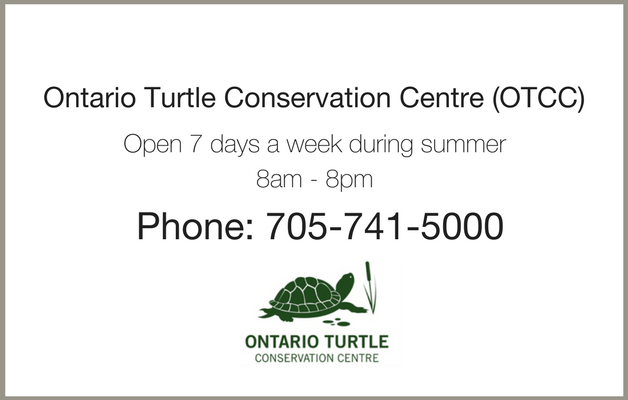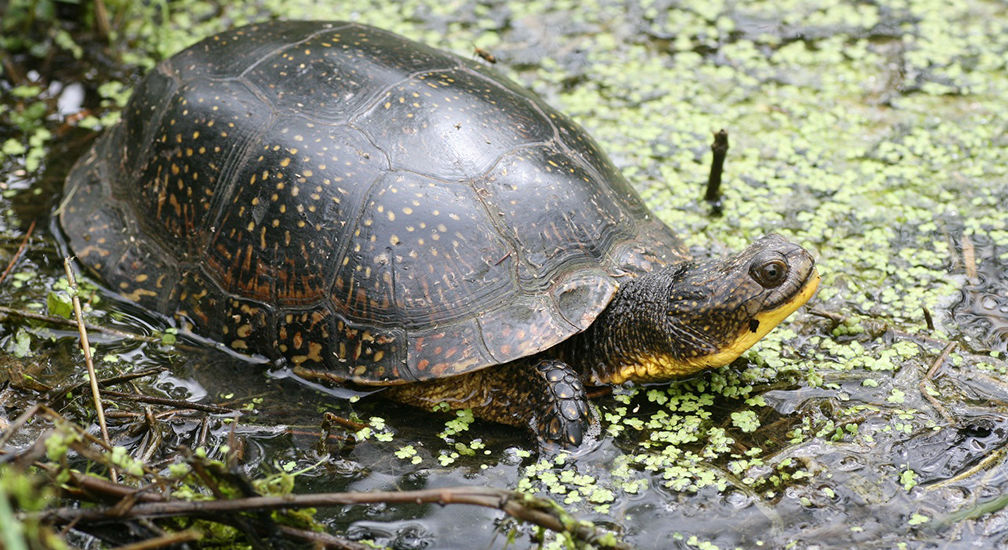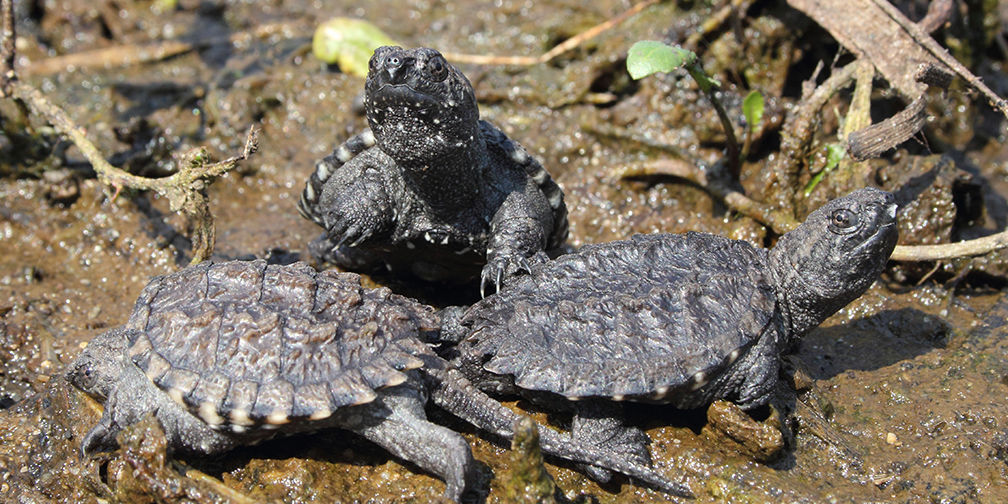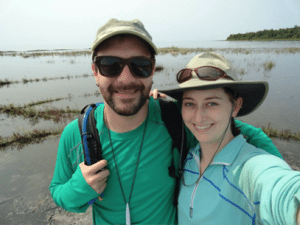Ontario Nature Blog
Receive email alerts about breaking conservation
and environmental news.
© Lora Denis
July 11, 2017–Guest blogger
How To•Reptiles and Amphibians•Species at Risk•Stewardship and restoration
© Gabriel Esler
Seven of Ontario’s eight turtle species are provincially at risk. By helping a turtle cross the road, you contribute to their conservation. But what if you spot a turtle that’s injured, or possibly dead? Check out our Q & A to help you take action during your travels.
Turtles are extremely robust, and can often survive run-ins with cars. Ontario Turtle Conservation Centre (OTCC) staff and volunteers rehabilitate injured turtles at the Turtle Trauma Centre so they can be returned to the wild. The centre operates from 8am – 8pm, seven days a week during the summer and works with rehabilitation centres all across the province. They are the best call to make no matter where you are in the province.

Often, turtles that appear to be dead are actually still alive. Turtles are ectothermic which means that the environment influences their body temperature. They are capable of holding their breath and slowing their heart rate. This can make them look dead when they’re not. All injured turtles should be brought to the OTCC. When moving a turtle off the road, carefully place it on the floor in the backseat of your car. The turtle can then be place in a vented box in a dark location while transport is being arranged with OTCC.
Many turtles hit by cars are females trying to find a nesting site. If a turtle is hit by a car and can’t be saved, staff at the OTCC may be able to remove her eggs and help them hatch. The death of a female doesn’t have to mean the death of her eggs. OTCC staff incubates about 2,000 eggs per year, and the hatchlings are released in appropriate wetlands near where the mother was found.

If you can’t drive an injured turtle to the OTCC, call 705-741-5000 to arrange transport through its Turtle Taxi Volunteer program. If the turtle needs immediate help, they will connect you with one of the 35 licensed First Response Centres located throughout Ontario, where the turtle can receive life-saving care before coming to the OTCC.
Turtles play a vital role in keeping wetlands healthy by eating plants and dead fish. You can think of them as the janitors of wetlands! Wetlands keep our water clean for drinking, fishing, and swimming.

Turtles face their greatest challenges as hatchlings, and the few that survive to adulthood (which takes 15-20 years in Ontario) are invaluable to their populations. Adults reproduce throughout their lifetime. Female snapping turtles can lay 20-60 eggs per year, and can live for more than 100 years. That’s a lot of eggs, but less than 1% of the young will reach adulthood!

It doesn’t matter if you spot a live, injured or dead turtle during your travels – you can directly help turtles you see on the road. By taking action, you’ll be contributing to the conservation of this ancient and precious species. Don’t forget to report your sightings to the Ontario Reptile and Amphibian Atlas. These data are used to identify areas that need mitigation such as ecopassages and assessing threats to these species.

Donnell Gasbarrini is the Turtle Programs Manager at the Ontario Turtle Conservation Centre. She has a Bachelor’s degree in Zoology from the University of Guelph, and a Master’s degree in Biology from Laurentian University.
Jesse Jarvis is a volunteer at the Ontario Turtle Conservation Centre, assisting with turtle husbandry. He has a Bachelor’s degree in Environmental Biology and a Master’s degree in Environmental Science from the University of Guelph.
Gananoque Lake Nature Reserve © Smera Sukumar
I tried to stop to help turtle across busy road but it was run over before I got to it. It was dead and people just kept driving over it ! There is a sign on Old Baseline Road in Caledon saying turtle crossing April to September but its not obvious and people just drive too fast here. I felt so sad and I cant forget how it was only a few minutes and I could have saved it.
It was hard to just stop on the busy road and the few minutes it took to be able to safely park on the side caused my failure to save it.
It was so awful.
Hi Christine,
Very sorry to hear about this experience. The wildlife crossing signs are important and considerably helpful, and drivers do need to be mindful and respect posted conditions en route.
For interest, here is a link to one of our ON Nature magazine articles about the importance of wildlife crossing passages; https://catalog.ontarionature.org/summer-2018/page/18-19
Noah
Good Afternoon, Could you please let mi know of Turtle Rescue Facility on Manitoulin Island if there is one. It happens sometimes I do come across injured turtles by the road side. Thank you for your work. Tomasz
Please help Raccoon got him tonight. He is alive. Head looks ok but feet are not good. What should I do.
Hello,
Please visit http://www.ontariowildliferescue.ca/wildlifecentres/ to find wildlife rescue centres near there. It would likely be the best idea now to bring both species to the respective rescue centre.
Noah
Such interesting article. Yesterday we were driving in a Muskoka highway and for the first time we saw our son (Wildlife Biologist) saving a turtle crossing on the highway. He works at Scales Natural Park.
Is is so important to know about this wonderful creatures. Thank you for the article David, so proud of your career and my son’s Alma Mater Guelph.
Last weekend I had to stop to help a Painted turtle to cross from one wet area to another on a dirt lane near our cottage. There were two cars following me and I am sure one of them would have run over it as it was in one of the tire tracks. Having read ON’s article I knew where I should place it on the shoulder and sure enough it kept going toward the wet area. The two drivers were perplexed but I explained what I did they they were in agreement. I hope they will now be more aware in the future.
Hi Otto, thanks for sharing your experience. Glad this article was able to help you take action!
Hi
I see and have helped many a turtle and would be happy to report all but your statement
(Don’t forget to report your sightings to the Ontario Reptile and Amphibian Atlas.) doesn’t lead to a place on the page I’m sent to, so that I can do report any turtles I see Make the link clearer, please . So far this year I have moved 3 large female snappers from roads in my area to a larger body of water I have 2 good size ponds on my property where there are anywhere from 5 to 15 turtle living freely, both snappers and paints. Also have helps a nest of eggs once they hatched.
Shirl Nelson
PS a good article to ad to your page would be how to move a large snapper off the road and where to put it for safety
Hi Shirl, thank you for your comment. The atlas page that links from ‘report your sightings’ will take you to our atlas web page where you can choose your preferred method of reporting a sighting (by online form, email, mail, or if you’re on mobile, via our Atlas app).
We’ve also included a link to a previous article on helping turtles cross the road when it is safe to do so, which can be found here: https://www.ontarionature.org/connect/blog/how-you-can-help-turtles-cross-the-road/
It’s great to hear you’ve been able to help turtles in your area! In general, it is best practice to move live turtles no more than is necessary (less than 10 metres) to move them off the road. Turtles have a high fidelity to their breeding, foraging and nesting sites, so moving them farther away can disorient them, which could affect their ability to survive. Contact professionals like those at the Ontario Turtle Trauma Centre (contact above) if you spot turtle eggs.
Hope this helps!
There is also Rideau Valley Wildlife Sanctuary close to Ottawa who take in injured and dead turtles in North Gover.
Hi Lisa, thanks for this added resource for our readers in the Ottawa area!
Thanks for sharing this. I would never have thought to bring a dead turtle in but it makes sense!
Hi Stephanie, glad you found this article helpful. Thanks for reading!